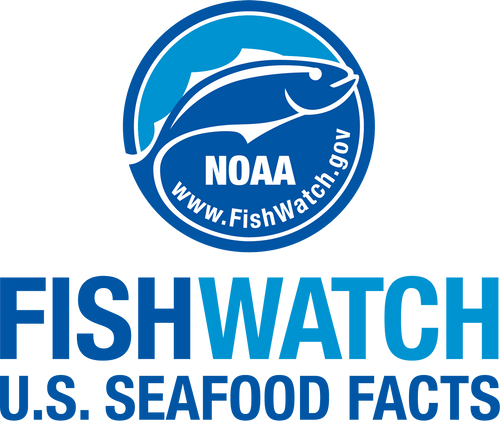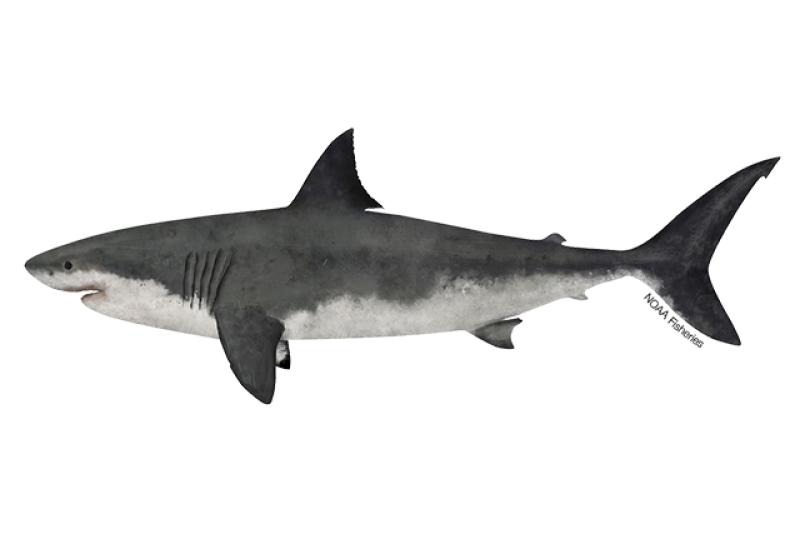 Common thresher shark. Credit: NOAA Fisheries/Walter Heim
Common thresher shark. Credit: NOAA Fisheries/Walter Heim
Common thresher shark. Credit: NOAA Fisheries/Walter Heim
About the Species
 Common thresher shark. Credit: NOAA Fisheries/Walter Heim
Common thresher shark. Credit: NOAA Fisheries/Walter Heim
Common thresher shark. Credit: NOAA Fisheries/Walter Heim
U.S. wild-caught Pacific common thresher shark is a smart seafood choice because it is sustainably managed and responsibly harvested under U.S. regulations.

Population
The stock is not overfished.

Fishing Rate
Not subject to overfishing.

Habitat Impact
Drift gillnets and harpoons used to catch common thresher sharks have no impact on habitat because they’re used in the water column and don’t contact the ocean floor.

Bycatch
Regulations are in place to minimize bycatch.
Population Status
- According to the 2018 stock assessment, Pacific common thresher shark is not overfished and not subject to overfishing. Summary stock assessment information can be found on Stock SMART.
Appearance
- Thresher sharks are brown, gray, blue-gray, or blackish on the back and underside of their snout.
- They are lighter on the sides, and fully white below.
- Fins are blackish, and some have white dots on the tips.
- Their tail fin is sickle-shaped, and the upper part is very long, about half the length of the body.
Biology
- Thresher sharks grow slowly, reaching lengths up to 18 feet.
- They live a long time, between 19 and 50 years.
- They mature when they reach about 5 years old and 5 feet in length.
- Thresher sharks mate in midsummer. Eggs are fertilized internally and develop inside the female.
- After a gestation period of about 9 months, females bear two to four live pups in the spring.
- Thresher sharks feed on small pelagic fish—including anchovies, sardines, hake, mackerel, and squid.
- They are named for their long, scythe-like tail, which they use to swat and stun fish before preying on them.
- Top-level predators, such as killer whales and larger sharks, prey on common threshers.
Where They Live
Range
- Thresher sharks are found in the Eastern Pacific Ocean from Goose Bay, British Columbia, south to Baja California. They’re also found off Panama and Chile.
- They migrate seasonally between Oregon/Washington and southern California/Baja Peninsula, Mexico.
Habitat
- Thresher sharks are highly migratory, and travel seasonally as temperatures change.
- They are commonly found close to shore in areas rich with plankton, where their prey is also abundant.
Fishery Management
- NOAA Fisheries and the Pacific Fishery Management Council manage the Pacific common thresher shark fishery on the West Coast.
- Managed under the Fishery Management Plan for U.S. West Coast Fisheries for Highly Migratory Species:
- Permits are needed to fish for highly migratory species, including thresher sharks, and fishermen must maintain logbooks documenting their catch.
- Annual commercial harvest guidelines (a general objective for how much can be caught).
- Closed areas protect endangered turtles, and gillnetting is prohibited within 3 miles of the coast where shark pups reside.
- Fishermen are required to take a training course on safe handling and release of protected species.
- Mandatory placement (about 20 percent coverage) of at-sea observers on commercial drift gillnet vessels to monitor catch, bycatch, and fishing effort.
- Fishing times and areas are tightly managed to reduce the risk of catching protected species, such as sea turtles, whales, and dolphins.
- NOAA Fisheries and the Western Pacific Regional Fishery Management Council manage the Pacific common thresher shark fishery in the Pacific Islands.
- Managed under the Fishery Ecosystem Plan for the Pelagic Fisheries of the Western Pacific:
- Entry to this fishery is limited to a maximum of 164 vessels.
- Permits and logbooks are required.
- Observers are required on all Hawaii-based longline vessels.
- NOAA Fisheries vessel monitoring system (VMS) program requires longline boats to be equipped with a satellite transponder that provides real-time vessel position updates and tracks vessel movements.
- Longlines are prohibited in certain areas to protect endangered Hawaiian monk seals and reduce the potential for gear conflicts and localized stock depletion.
- Vessels operating under longline general permits must carry special gear to release incidentally hooked or entangled sea turtles.
- There are no management measures specific to Pacific common thresher sharks, because in the Western Pacific they’re only harvested incidentally in the longline fishery for swordfish.
- The Shark Conservation Act requires that all sharks, with one exception, be brought to shore with their fins naturally attached.
- Management of highly migratory species, like thresher sharks, is complicated because the species migrate thousands of miles across international boundaries and are fished by many nations.
- Two international organizations, the Inter-American Tropical Tuna Commission (IATTC) and the Western and Central Pacific Fisheries Commission (WCPFC) manage highly migratory species, like sharks, internationally.
- No international measures are in place specific to common thresher sharks, but both organizations have passed shark conservation and management measures that combat shark finning practices and encourage further research and periodic stock assessment efforts for sharks.
Harvest
- In 2022, commercial landings of thresher shark on the West Coast totaled 97,000 pounds and were valued at more than $71,000, according to the NOAA Fisheries commercial fishing landings database.
- Most thresher shark is landed in California.
- Gear types and bycatch:
- Drift gillnets are used to catch common thresher sharks.
- Drift gillnets can incidentally catch other species, such as ocean sunfish and blue sharks.
- Protected species, such as sperm whales and sea turtles, may be caught as bycatch in drift gillnet fisheries.
- Managers limit where and when drift gillnet fishermen can fish to help prevent bycatch. Logbooks and observer programs help monitor bycatch.
- The California thresher shark gillnet fishery is a Category I fishery, meaning it has frequent incidental mortality or serious injury of marine mammals.
- NOAA Fisheries works with the federally appointed Pacific Offshore Cetacean Take Reduction Team to develop measures that reduce the impacts of this fishery on certain marine mammals.
- On the West Coast, recreational catch varies but has averaged roughly 20 metric tons in recent years. Recreational fishermen have daily bag limits for thresher sharks.
Scientific Classification
- Thresher sharks are found in the Eastern Pacific Ocean from Goose Bay, British Columbia, south to Baja California. They’re also found off Panama and Chile.
- They migrate seasonally between Oregon/Washington and southern California/Baja Peninsula, Mexico.
- Thresher sharks are highly migratory, and travel seasonally as temperatures change.
- They are commonly found close to shore in areas rich with plankton, where their prey is also abundant.
Fishery Management
- NOAA Fisheries and the Pacific Fishery Management Council manage the Pacific common thresher shark fishery on the West Coast.
- Managed under the Fishery Management Plan for U.S. West Coast Fisheries for Highly Migratory Species:
- Permits are needed to fish for highly migratory species, including thresher sharks, and fishermen must maintain logbooks documenting their catch.
- Annual commercial harvest guidelines (a general objective for how much can be caught).
- Closed areas protect endangered turtles, and gillnetting is prohibited within 3 miles of the coast where shark pups reside.
- Fishermen are required to take a training course on safe handling and release of protected species.
- Mandatory placement (about 20 percent coverage) of at-sea observers on commercial drift gillnet vessels to monitor catch, bycatch, and fishing effort.
- Fishing times and areas are tightly managed to reduce the risk of catching protected species, such as sea turtles, whales, and dolphins.
- NOAA Fisheries and the Western Pacific Regional Fishery Management Council manage the Pacific common thresher shark fishery in the Pacific Islands.
- Managed under the Fishery Ecosystem Plan for the Pelagic Fisheries of the Western Pacific:
- Entry to this fishery is limited to a maximum of 164 vessels.
- Permits and logbooks are required.
- Observers are required on all Hawaii-based longline vessels.
- NOAA Fisheries vessel monitoring system (VMS) program requires longline boats to be equipped with a satellite transponder that provides real-time vessel position updates and tracks vessel movements.
- Longlines are prohibited in certain areas to protect endangered Hawaiian monk seals and reduce the potential for gear conflicts and localized stock depletion.
- Vessels operating under longline general permits must carry special gear to release incidentally hooked or entangled sea turtles.
- There are no management measures specific to Pacific common thresher sharks, because in the Western Pacific they’re only harvested incidentally in the longline fishery for swordfish.
- The Shark Conservation Act requires that all sharks, with one exception, be brought to shore with their fins naturally attached.
- Management of highly migratory species, like thresher sharks, is complicated because the species migrate thousands of miles across international boundaries and are fished by many nations.
- Two international organizations, the Inter-American Tropical Tuna Commission (IATTC) and the Western and Central Pacific Fisheries Commission (WCPFC) manage highly migratory species, like sharks, internationally.
- No international measures are in place specific to common thresher sharks, but both organizations have passed shark conservation and management measures that combat shark finning practices and encourage further research and periodic stock assessment efforts for sharks.
Harvest
- In 2022, commercial landings of thresher shark on the West Coast totaled 97,000 pounds and were valued at more than $71,000, according to the NOAA Fisheries commercial fishing landings database.
- Most thresher shark is landed in California.
- Gear types and bycatch:
- Drift gillnets are used to catch common thresher sharks.
- Drift gillnets can incidentally catch other species, such as ocean sunfish and blue sharks.
- Protected species, such as sperm whales and sea turtles, may be caught as bycatch in drift gillnet fisheries.
- Managers limit where and when drift gillnet fishermen can fish to help prevent bycatch. Logbooks and observer programs help monitor bycatch.
- The California thresher shark gillnet fishery is a Category I fishery, meaning it has frequent incidental mortality or serious injury of marine mammals.
- NOAA Fisheries works with the federally appointed Pacific Offshore Cetacean Take Reduction Team to develop measures that reduce the impacts of this fishery on certain marine mammals.
- On the West Coast, recreational catch varies but has averaged roughly 20 metric tons in recent years. Recreational fishermen have daily bag limits for thresher sharks.
Scientific Classification
| Kingdom | Animalia | Phylum | Chordata | Class | Chondrichthyes | Order | Lamniformes | Family | Alopiidae | Genus | Alopias | Species | vulpinus |
|---|
Last updated by NOAA Fisheries on 06/14/2024
Featured News
 Schooling hammerhead sharks. Credit: iStock.
Schooling hammerhead sharks. Credit: iStock.
Seafood Facts

Is Pacific Common Thresher Shark Sustainable?
U.S. wild-caught Pacific common thresher shark is a smart seafood choice because it is sustainably managed and responsibly harvested under U.S. regulations.
Availability
Year-round.
Source
U.S. wild-caught from California and the Pacific Islands.
Taste
Mild flavor.
Texture
Firm, dense, and meat-like.
Color
Raw meat is white to tan with a pink blood line.
Health Benefits
High in protein, low in fat, and a good source of niacin, vitamin B6, phosphorous, and selenium.
Nutrition Facts
Servings: 1; Serving Weight: 100 g (raw); Calories: 130; Protein: 20.98 g; Total Fat: 4.51 g; Total Saturated Fatty Acids: 0.925 g; Carbohydrate: 0 g; Total Sugars: 0 g; Total Dietary Fiber: 0 g; Cholesterol: 51 mg; Selenium: 36.5 mcg; Sodium: 79 mgMore Information
Last updated by NOAA Fisheries on 06/14/2024
Seafood News
 Credit: NOAA Fisheries/Brianna Shaughnessy
Credit: NOAA Fisheries/Brianna Shaughnessy
 An oyster reef with lush greenery in the background. Credit: Adobe Stock
An oyster reef with lush greenery in the background. Credit: Adobe Stock
 A fisherman unloading their catch at dock. Credit: NOAA Fisheries
A fisherman unloading their catch at dock. Credit: NOAA Fisheries
Documents
Endangered Species Act Status Review of Common Thresher (Alopias vulpinus) and Bigeye Thresher (Alopias superciliosus) Sharks
The 2016 status review report conducted on two petitions to list the common and bigeye thresher…
Data & Maps
American Samoa Longline Logbook Reports 2022
Logbook summary reports for the 2022 calendar year.
Hawaii and California Longline Logbook Reports 2022
Logbook summary reports for the 2022 calendar year.
Hawaii and California Longline Logbook Reports 2021
Logbook summary reports for the 2021 calendar year.
American Samoa Longline Logbook Reports 2021
Logbook summary reports for the 2021 calendar year.
Research
Coastal Pelagic and Highly Migratory Species Life History Research in the Pacific
The Life History Program researches the reproductive biology, growth, foraging ecology, and distribution of highly migratory and coastal pelagic species in the northeast Pacific Ocean. Through biological sampling, soft and hard tissue analysis,…
Last updated by NOAA Fisheries on 06/14/2024




